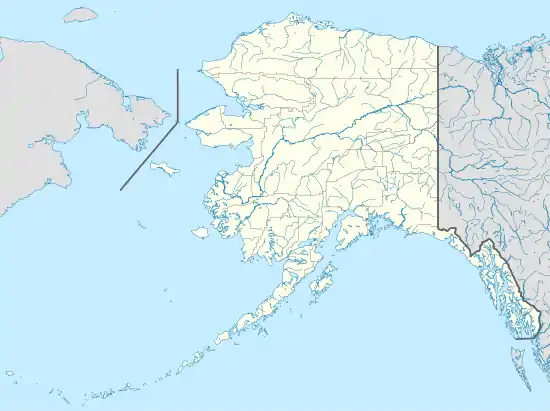Kijik, Alaska
Kijik is a ghost town in Lake and Peninsula Borough, Alaska, United States. An Athabascan village that was established on the shores of Lake Clark in the Alaska Range, its population was recorded at 91 in the 1880 United States Census and declined thereafter, falling to approximately 25 individuals by 1904. Today, the village has been abandoned. The ghost town is located within the bounds of Lake Clark National Park and Preserve.
Kijik Archeological District | |
.jpg.webp) Scenery in the district | |
 | |
| Location | Address restricted[1], Lake Clark National Park and Preserve |
|---|---|
| Nearest city | Port Alsworth, Alaska |
| Area | 1,920 acres (780 ha) |
| NRHP reference No. | 94001644 |
| Significant dates | |
| Added to NRHP | October 12, 1994[2] |
| Designated NHLD | October 12, 1994[3] |
Kijik Historic District | |
| Location | Address restricted[1], Lake Clark National Park and Preserve |
| Nearest city | Port Alsworth, Alaska |
| Area | 12 acres (4.9 ha) |
| NRHP reference No. | 79000410[2] |
| Added to NRHP | January 29, 1979 |
The historic portion of the village was the subject of archaeological and ethnological research in the 1960s. Interviews with Dena'ina elders in Nondalton established that the people of Kijik relocated to Old Nondalton (not far from present-day Nondalton) in the early 19th century, probably to be closer to trading posts and the canneries of Bristol Bay. A survey expedition that visited the site in 1909 reported it to be abandoned. A major archaeological excavation of the historic village took place in 1966, exposing twelve foundational remnants of log houses (many of the houses having apparently been moved to Old Nondalton at the time of the relocation), and two of what appeared to be larger communal structures.[4]
In 1979, twelve acres of the village site were added to the National Register of Historic Places as a historic district.[2] A much larger area, encompassing a significant number of archaeological sites related to the habitation and use of the area from at least the 12th century forward, was designated a National Historic Landmark District in 1994, for the unique concentration of sites related to the inland Dena'ina people.[3][5]
The community was known by many other names than "Kijik" during its history, including "Lake Clark Village", "Nijik", "Nikhkak", "Nikhak", and "Old Keegik". Its current name has been spelled in a wide variety of ways, including "Keechik", "Keeghik", "Keejik", "Keggik", "Keygik", "Kichak", "Kichik", "Kilchik", and "Kilchikh".
Demographics
| Historical population | |||
|---|---|---|---|
| Census | Pop. | %± | |
| 1880 | 91 | — | |
| 1890 | 42 | −53.8% | |
| U.S. Decennial Census[6] | |||
Kijik first appeared on the 1880 U.S. Census as the unincorporated Tinneh village of "Kichik."[7] It appeared again on the 1890 U.S. Census as "Nikhkak." It has not reported since and was abandoned after 1900.
See also
References
- Federal and state laws and practices restrict general public access to information regarding the specific location of this resource. In some cases, this is to protect archeological sites from vandalism, while in other cases it is restricted at the request of the owner. See: Knoerl, John; Miller, Diane; Shrimpton, Rebecca H. (1990), Guidelines for Restricting Information about Historic and Prehistoric Resources, National Register Bulletin, National Park Service, U.S. Department of the Interior, OCLC 20706997.
- "National Register Information System". National Register of Historic Places. National Park Service. March 13, 2009.
- "Kijik Archeological District". National Historic Landmark summary listing. National Park Service. Archived from the original on 2011-06-06. Retrieved 2008-01-04.
- Vanstone, James; Townsend, Joan (January 16, 1970). "Kijik: An Historic Tanaina Settlement". Fieldiana: Anthropology. 15: 1–202. JSTOR 29782443.
- "National Park Service Cultural Landscapes Inventory Professional Procedures Guide" (PDF). National Park Service. Retrieved 2014-12-05.
- "U.S. Decennial Census". Census.gov. Archived from the original on May 12, 2015. Retrieved June 6, 2013.
- "Geological Survey Professional Paper". 1949.
| Wikimedia Commons has media related to Kijik Archeological District. |


.svg.png.webp)